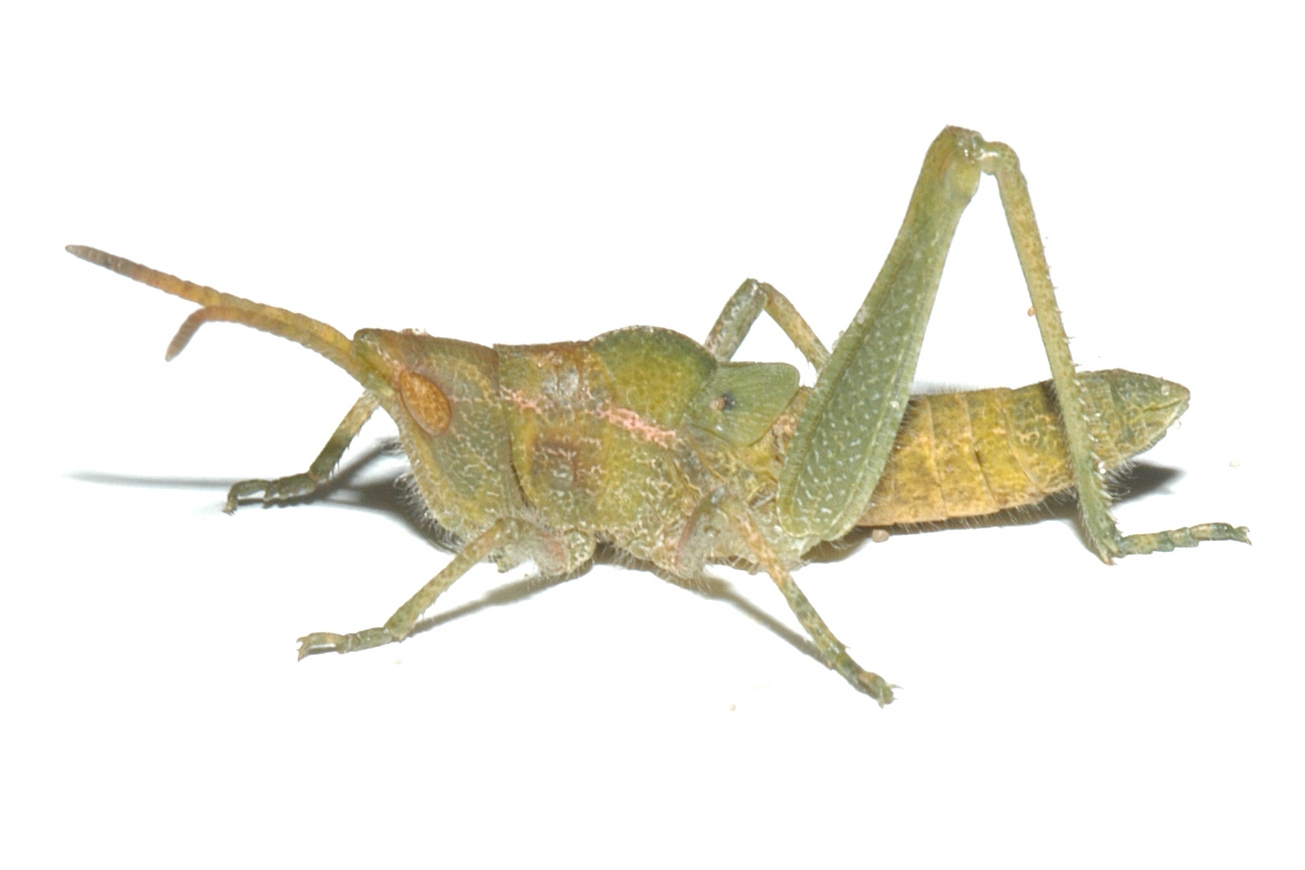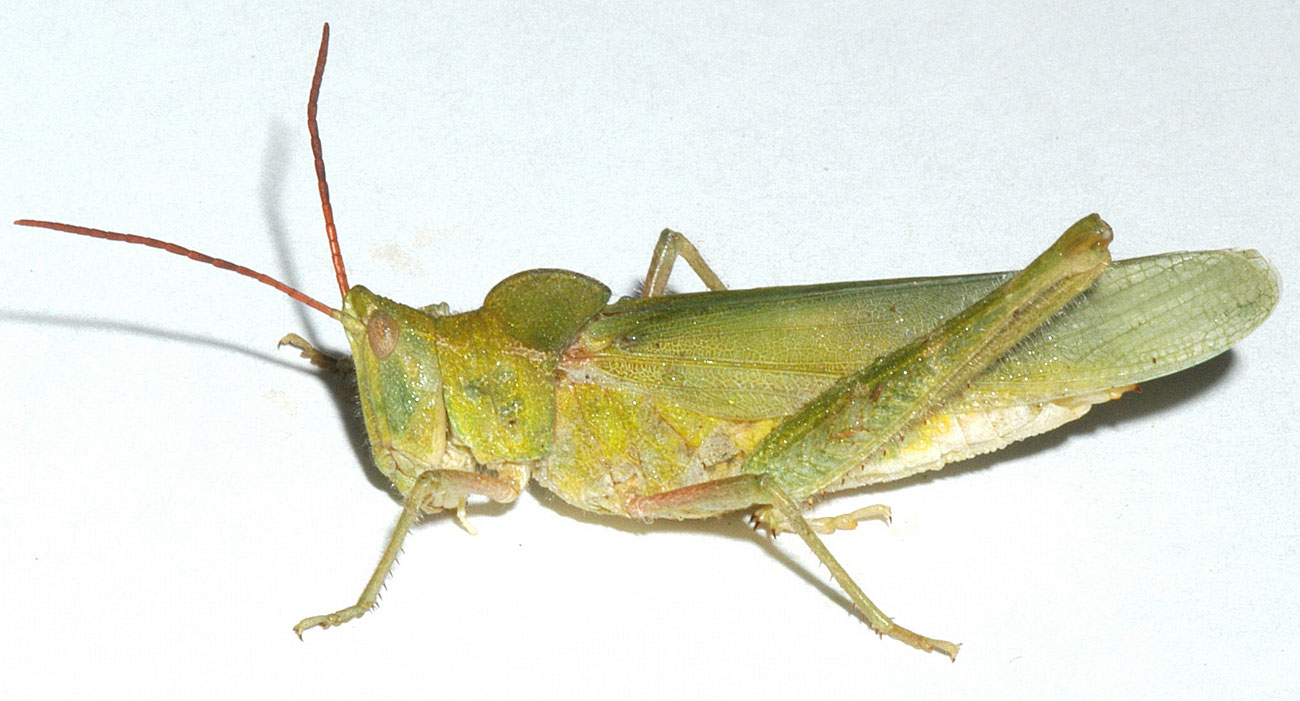Acrolophitus hirtipes
|
Geographic range of Acrolophitus hirtipes (Say)
|
|
Fig. 1, fourth instar
|
|
Fig. 2, adult male: BL 24-30 mm, FL 14-18 mm, AS 22-25
|
|
Fig. 3, adult female: BL 29-39 mm, FL 19-22 mm, AS 19-23
|
|
Fig. 4, dorsal view of green fool grasshopper
|
Species
Green fool grasshopper
Acrolophitus hirtipes (Say)
Subfamily Gomphocerinae
Identification
The green fool grasshopper is a relatively large grasshopper that is entirely green across much of its range. In more southern parts of its range it can be somewhat blotchy in appearance, with areas of dark green interspersed with pale greenish. The antennae are comparatively long, and the body, especially the hind femora, are largely covered with a scattering of long setae, giving it a hairy appearance. The pronotum is developed into an enlarged crest, creating the appearance of a pronounced hump when viewed laterally. It can be distinguished from Tropidolophus formosus (not in key) by the smooth edge of the crest, which in T. formosus is jagged. The hind femur is generally uniform green on both the inner and outer surfaces, and the hind tibiae are also green. The hind wings are pale greenish with a blackish band. It is unusual among the Gomphocerinae (slantfaced grasshoppers) in both its banded hind wings and diet.
Distribution and habitat
Acrolophitus hirtipes occurs from Alberta and Saskatchewan to across the short-grass and mixed-grass prairies to Texas. It is most numerous is short-grass rangeland and in mixed grass communities with numerous bare patches but is never common. It appears to be most consistent in areas predominated by sparse, weedy vegetation.
Economic importance
Because this grasshopper feeds almost entirely on weedy forbs and is never abundant, it is not expected to be of any economic importance in rangeland.
Food preferences
Unlike most other gomphorcerines, this grasshopper feeds mostly on forbs. In Manitoba it has been recorded to feed almost exclusively on members of the Boraginaceae, with a preference for Lithospermum, Lappula, Echium, and Myosotis. In Nebraska, only Lappula redowski was found in crop contents. In South Dakota it was also reported to feed mostly on members of the borage family, with a preference for stickseed, cryptantha, and members of the genus Phasuba.
Dispersal and migration
Nothing is recorded on the dispersal ability of this grasshopper, but is has been observed to be a comparatively clumsy flier. While it could potentially disperse moderate distances, swarms are very unlikely as it is a comparatively rare grasshopper.
Hatching
Little is known about its development, but it probably overwinters in the egg stage and hatches comparatively early in the spring. In Texas eggs might hatch in fall and nymphs may overwinter.
Nymphal development
It typically molts through five instars. In Texas nymphs are found in March and April, but in Nebraska they have been collected mostly in May and June. Nymphs likely develop fairly rapidly as adults have been found as early as mid-June (Nebraska), and it may overwinter in the nymphal stage in the southern parts of its range.
Adults and reproduction
As this grasshopper possesses banded hind wings, it presumed that flight signals may be important in courtship. Single males may stridulate when near females. Egg pods do not contain froth. Pods usually contain six tan eggs which average 6.4 mm in length and 1.5 mm in width. It presumably oviposits in bare areas in sparsely vegetated rangeland. In Texas, adults are common in May and June, and become rare in July and August. In most of the Great Plains, adults are most common in July and August, but have been collected from June to September.
Population ecology
No studies have been done on the population ecology of the green fool grasshopper. Observations in Nebraska suggest that it tends to occur at low to moderate densities in limited areas where its preferred host plants are numerous.
Daily activity
Little is known of the daily activity of the green fool grasshopper.
Source and date
University of Nebraska, March 2007 by Mathew L. Brust
Selected references
Anderson, N. L., and J. C. Wright. 1952. Grasshopper investigations on Montana range lands. Montana State College Argriculture Experiment Station Bulletin 486. 46 pp.
Brooks, A. R. 1958. Acridoidea of southern Alberta, Saskatchewan, and Manitoba. Supplement 9, Canadian Entomologist 90: 1-92.
Brusven, M. A. 1967. Differentiation, ecology and distribution of immature slant faced grasshoppers (Acridinae) in Kansas. Kansas Agriculture Experiment Station Technical Bulletin 149: 1-59.
Criddle, N. 1933. Studies in the biology of North American Acrididae, development and habits. Proceedings of the World’s Grain Exhibition Conference, Canada 2: 474-494.
Helfer, J. R. 1987. How to Know the Grasshoppers, Crickets, Cockroaches and Their Allies. Dover Publications Inc. New York, New York. 363 pp. Isley, F. B. 1937. Northeastern Texas acridians. Ecological Monographs 7: 318-344.
McDaniel, B. 1987. Grasshoppers of South Dakota. South Dakota Agriculture Experiment Station Publication TB 89. 163 pp.
Mulkern, G. B., K. P. Pruess, H. Knutson, A. F. Hagen, J. B. Campbell, and J. D. Lambley. 1969. Food habits and preferences of grassland grasshoppers of the north central Great Plains. North Dakota State University Agricultural Experiment Station, North Central Regional Publication no. 196. 32 pp.
Onsager, J. A., and C. B. Mulkern. 1963. Identification of eggs and egg pods of North Dakota grasshoppers (Orthoptera: Acrididae). North Dakota Agriculture Experiment Station Bulletin 446: 1-48.
Otte, D. 1970. A comparative study of communicative behavior in grasshoppers. Miscellaneous Publications of the University of Michigan Museum of Zoology no. 141: 1-168.
Otte, D. 1981. The North American grasshoppers, Volume I, Acrididae: Gomphocerinae and Acridinae. Harvard University Press, Cambridge, Massachusetts. 368 pp.




